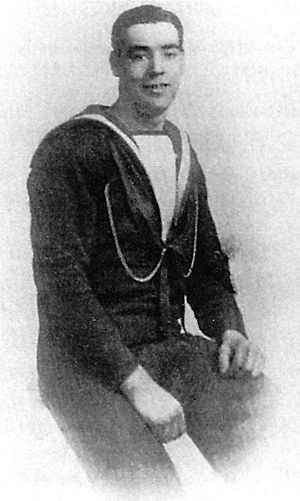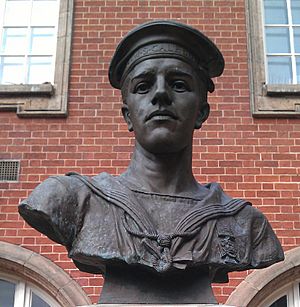John Henry Carless facts for kids
Quick facts for kids
John Henry Carless
|
|
|---|---|

John Henry Carless
|
|
| Born | 11 November 1896 Walsall, England |
| Died | 17 November 1917 (aged 21) HMS Caledon, Heligoland Bight, off German Empire |
| Buried |
at sea
|
| Allegiance | |
| Service/ |
|
| Years of service | 1914–1917 † |
| Rank | Ordinary Seaman |
| Unit | HMS Caledon |
| Battles/wars | World War I
|
| Awards | Victoria Cross |
John Henry Carless (born 11 November 1896 – died 17 November 1917) was a brave British sailor. He received the Victoria Cross, the highest award for bravery, during World War I. He was honored for his amazing courage in battle.
Contents
John Henry Carless was born in 1896 in Walsall, England. His father, John Thomas Carless, worked in an iron foundry. John had two sisters, Ada and Dora. They all lived on Tasker Street.
John was good at sports. He even played football in a big final match at Roker Park. After school, he started working as an errand boy for a company that made leather goods.
When World War I began, John wanted to join the army. He tried four times but was turned down. Doctors said he had a "weak heart." However, his application to join the Royal Navy was accepted. He joined the Navy on 1 September 1915. His service number was J43703.
Heroic Actions and the Victoria Cross
John Henry Carless was an Ordinary Seaman in the Royal Navy. He was only 21 years old when he died. He earned the Victoria Cross for his incredibly brave actions. This happened on 17 November 1917, during the Second Battle of Heligoland Bight. He was serving aboard HMS Caledon off the coast of Germany.
In November 1917, British ships fought German forces in the North Sea. During this battle, Seaman Carless was hit by a piece of shrapnel. This caused a serious injury to his stomach. Even though he was badly hurt, he kept loading his gun. He also encouraged his shipmates to keep fighting.
After a while, another sailor took his place. John then collapsed and sadly died from his wounds. He was buried at sea the next day.
The commander of HMS Caledon, H.S. Harrison-Wallace, wrote a letter to John's parents. He told them how brave John was. He said, "He was a most gallant lad and very promising." The commander also said that John did his duty bravely for his King and country.
In June 1918, John's parents received his Victoria Cross. King George V presented them with the award after John's death.
Remembering John Henry Carless
People in Walsall, John's hometown, raised money to create a memorial for him. A bronze bust, which is a sculpture of his head and shoulders, was made by Robert Jackson Emerson. It stands on a large stone base outside the Walsall Museum.
On 20 February 1920, Admiral Sir Walter Cowan officially revealed the memorial. Admiral Cowan's ship had been HMS Caledon, the same ship John served on. The ship's white ensign (flag) was given to Walsall's mayor that day.
John Carless is also remembered at the Portsmouth Naval Memorial. This memorial lists the names of sailors who died at sea. In Walsall, three streets are named after him: Carless Street, Caledon Street, and Caledon Place. A blue plaque on Carless Street explains why the street is named that way.
In December 2009, a special plaque was put up at Walsall Town Hall. It honors John Carless and two other local heroes who also received the Victoria Cross. In 2014, a memorial paving stone was placed at St Mary's the Mount Catholic Primary School in Walsall. This is where John Carless went to school.
Museum Exhibits
The former Walsall Museum had a display about John Carless. It included a copy of his Victoria Cross. The original medal is kept safe in storage. The display also had the name-band from his uniform cap and an oil painting of him. After the Walsall Museum closed, this display moved to the Walsall Leather Museum.


